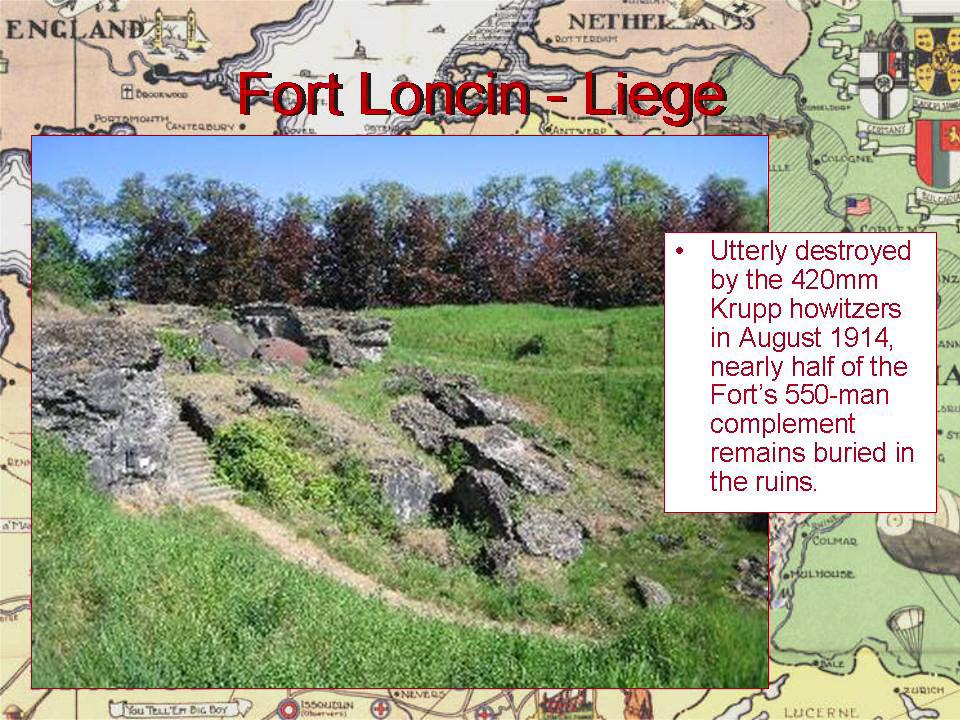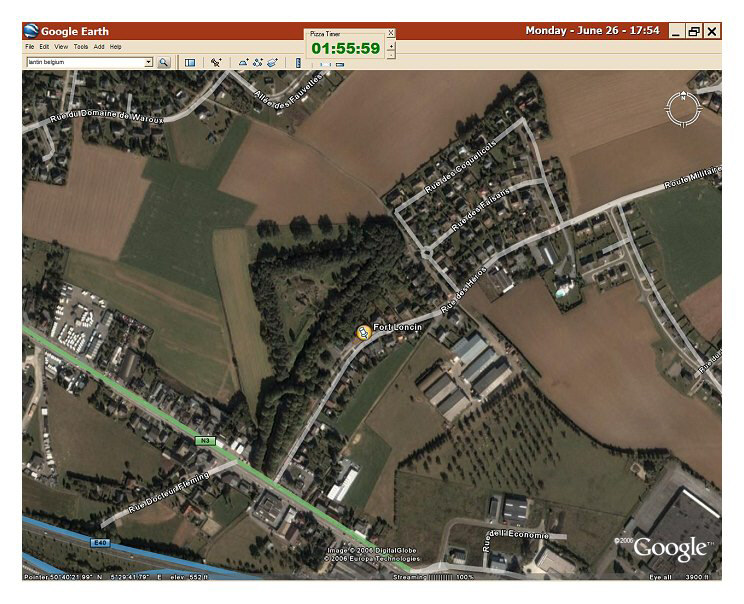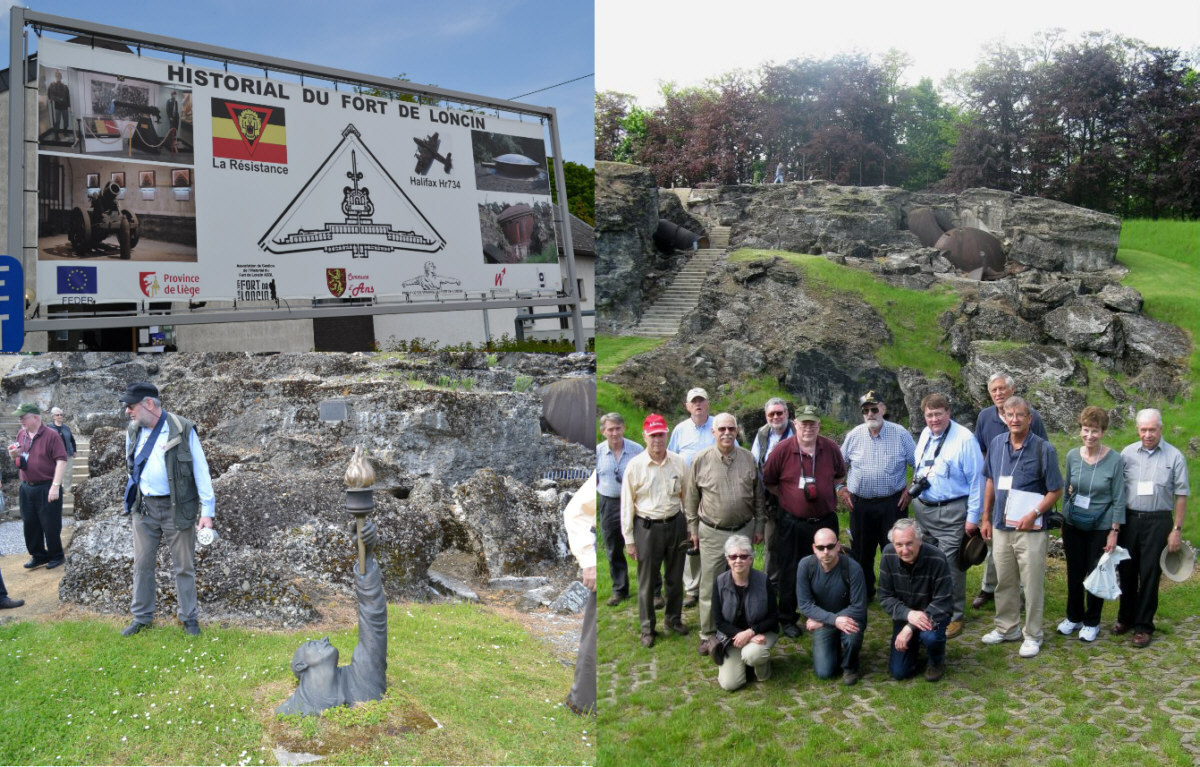
Click on Image to Expand

When they attacked in August 1914, the Germans surprised the Belgians, overran the ring of forts at Namur in four days, and, passing through gaps between forts, rapidly occupied Liège on the Meuse River. When heavy guns arrived, the Germans reduced the surrounding Liège forts one by one using 21cm Skoda mortars and, later, 42cm Krupp "Big Berthas". Fort de Loncin, headquarters of the Belgian commander, General Gérard Leman, was one of the last to fall, being destroyed 15 August when its magazine blew up after being penetrated by a "Big Bertha" round. Over half of the fort's garrison of 550 men were buried beneath the ruins of the fort, which was never rebuilt in the inter-war period and remains a memorial to these Belgian dead. General Leman, incidentally, survived the blast, spent the remainder of the war as a prisoner of war, and was treated as a national hero afterward.

Aerial View of the Triangular Fort
An early visitor described the damage:
We [could] not look at what was left of Fort Loncin. Literally nothing was left of it. As a fort it was gone, obliterated, wiped out, vanished. It had been of a triangular shape. It was of no shape now. We found it difficult to believe that the work of human hands had wrought destruction so utter and overwhelming. Where masonry walls had been was a vast junk heap; where stout magazines had been bedded down in hard concrete was a crater; where strong barracks had stood was a jumbled, shuffled nothingness.
Standing there on the shell-torn hilltop, looking across to where the Krupp surprise wrote its own testimonials at its first time of using, in characters so deadly and devastating, I found myself somehow thinking of that foolish nursery tale wherein it is recited that a pig built himself a house of straw, and the wolf came; and he huffed and he puffed and he blew the house down. The noncommissioned officer told us an unknown number of the defenders, running probably into the hundreds, had been buried so deeply beneath the ruins of the fort in the last hours of the fighting that the Germans had been unable to recover the bodies. Even as he spoke a puff of wind brought to our nostrils a smell which, once a man gets it into his nose, he will never get the memory of it out again so long as he has a nose. Being sufficiently sick, we departed thence.
War Correspondent Irvin S. Cobb, from Paths of Glory
Click on Image to Expand

Aerial View of the Triangular Fort
An early visitor described the damage:
We [could] not look at what was left of Fort Loncin. Literally nothing was left of it. As a fort it was gone, obliterated, wiped out, vanished. It had been of a triangular shape. It was of no shape now. We found it difficult to believe that the work of human hands had wrought destruction so utter and overwhelming. Where masonry walls had been was a vast junk heap; where stout magazines had been bedded down in hard concrete was a crater; where strong barracks had stood was a jumbled, shuffled nothingness.
Standing there on the shell-torn hilltop, looking across to where the Krupp surprise wrote its own testimonials at its first time of using, in characters so deadly and devastating, I found myself somehow thinking of that foolish nursery tale wherein it is recited that a pig built himself a house of straw, and the wolf came; and he huffed and he puffed and he blew the house down. The noncommissioned officer told us an unknown number of the defenders, running probably into the hundreds, had been buried so deeply beneath the ruins of the fort in the last hours of the fighting that the Germans had been unable to recover the bodies. Even as he spoke a puff of wind brought to our nostrils a smell which, once a man gets it into his nose, he will never get the memory of it out again so long as he has a nose. Being sufficiently sick, we departed thence.
War Correspondent Irvin S. Cobb, from Paths of Glory
Click on Image to Expand


I visited the site in 1996. with a museum group. They were trying to restore the surviving casemates. it appears they succeeded!
ReplyDeleteI'm in the 2012 photograph shown. My most vivid impression of the site was the power of the magazine explosion that tossed the fort's artillery pieces straight up from their turrets. Then I was amazed that ANY of the defenders of the fort could have survived that blast.
ReplyDeleteI can't imagine how terrifying it must have been to be in the underground chambers of the fort, and listening the sound of the shells hitting the casements above, and knowing that you have no escape from them.
ReplyDelete